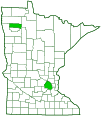Maculated dung beetle
(Aphodius distinctus)
Conservation • Description • Habitat • Ecology • Distribution • Taxonomy
Conservation Status |
|||
| IUCN Red List | not listed |
||
| NatureServe | NNR - Unranked |
||
| Minnesota | not listed |
||
Description |
Maculated dung beetle small aphodine dung beetle is native to Europe, Asia, and Northern Africa. It was introduced into and is now widespread in North America. Adults are ⅛″ to ¼″ long. The body is stout and is elongated, more so than dung beetles (subfamily Scarabaeinae) and tumblebugs (Canthon sp.). The head is black. It is not concealed beneath the pronotum. The antennae have 8 to 11 segments and are fan-shaped at the tip. The last three segments have long projections on one side that can be tightly closed. The exoskeletal plate covering the thorax (pronotum) is black. The hard forewings (elytra) are ridged longitudinally and black with highly variable yellow markings. The triangular plate between the wing bases (scutellum) is well developed. The legs are black. The hind legs are closer to the tip of the abdomen than to the middle legs. The fourth segment (tibia) of the middle and hind legs have keel-shaped ridges. The end segment of each leg (tarsus) has 5 sections. |
Size |
Total length: ⅛″ to ¼″ |
Similar Species |
Habitat |
Pastures |
Ecology |
Season |
March to May and August to October |
Behavior |
|
Life Cycle |
Adults overwinter. They emerge from hibernation and mate in the spring. The female lays eggs in the soil or in an underground dung ball. Larvae are most abundant in June and July. The new adults emerge in August or September and hibernate in late October or November. |
Larva Food |
Underground balls of dung of mammals, especially cattle; rotting plant material; and possibly plant roots. |
Adult Food |
Dung of mammals, especially cattle. |
Distribution |
||
|
Sources |
|
| 9/17/2025 | ||
Occurrence |
||
Common and widespread |
||
Taxonomy |
|
Order |
Coleoptera (Beetles) |
Suborder |
Polyphaga (Water, Rove, Scarab, Long-horned, Leaf, and Snout Beetles) |
Infraorder |
Scarabaeiformia |
Superfamily |
Scarabaeoidea (Scarabs, Stag Beetles, and Allies) |
Family |
Scarabaeidae (scarabs) |
Subfamily |
Aphodiinae (small dung beetles) |
| Tribe | Aphodiini |
| Subtribe | Aphodiina |
| Genus | Chilothorax |
This species was formerly clasified as Aphodius distinctus and was placed in the subgenus Chilothorax. That subgenus has been raised to full genus rank. |
|
Subordinate Taxa |
|
|
|
Synonyms |
|
Aphodius anxius Aphodius auctus Aphodius baseolus Aphodius centrolineatoides Aphodius confluens Aphodius distinctoides Aphodius distinctus Aphodius fumosus Aphodius hemicyclus Aphodius humeralis Aphodius hypocoprus Aphodius inquinatulus Aphodius interruptus Aphodius libyanus Aphodius lopezromeui Aphodius lunatus Aphodius maculipennis Aphodius nubiloides Aphodius ophthalmicus Aphodius pauper Aphodius pseudonubilus Aphodius pulcheroides Aphodius scutellaris Aphodius striatulus Aphodius subcinctus Aphodius subconfluens Aphodius trifasciatus Scarabaeus attaminatus Scarabaeus centrolineatus Scarabaeus foedatus Scarabaeus inquinatus Scarabaeus nubilus |
|
Common Names |
|
maculated dung beetle |
|
Glossary
Elytra
The hardened or leathery forewings of beetles used to protect the fragile hindwings, which are used for flying. Singular: elytron.
Pronotum
The exoskeletal plate on the upper side of the first segment of the thorax of an insect.
Scutellum
The exoskeletal plate covering the rearward (posterior) part of the middle segment of the thorax in some insects. In Coleoptera, Hemiptera, and Homoptera, the dorsal, often triangular plate behind the pronotum and between the bases of the front wings. In Diptera, the exoskeletal plate between the abdomen and the thorax.
Tarsus
The last two to five sections of an insect’s leg, attached to the tibia; the foot. Plural: tarsi.
Tibia
The fourth segment of an insect leg, after the femur and before the tarsus (foot). The fifth segment of a spider leg or palp. Plural: tibiae.
Visitor Photos
Share your photo of this insect.
This button not working for you?
Simply email us at info@MinnesotaSeasons.com.
Attach one or more photos and, if you like, a caption.
S. |
||
flew/fell down the back of my dress while sitting/lounging on our 3rd floor balcony. |
||
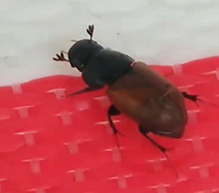 |
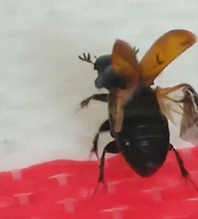 |
|
Bill Reynolds |
||
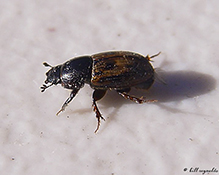 |
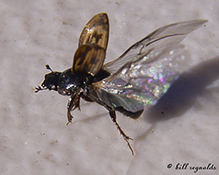 |
|
MinnesotaSeasons.com Photos
|

Slideshows

Visitor Videos
Share your video of this insect.
This button not working for you?
Simply email us at info@MinnesotaSeasons.com.
Attach a video, a YouTube link, or a cloud storage link.
Other Videos
Dung beetle evacuation
Morten DD Hansen
EATING DUNG BEETLES
BFvsGF

Visitor Sightings
Report a sighting of this insect.
This button not working for you?
Simply email us at info@MinnesotaSeasons.com.
Be sure to include a location.
S.
7/15/2020
Location: Valley View & Mitchell Rd, Eden Prairie, MN
flew/fell down the back of my dress while sitting/lounging on our 3rd floor balcony.
Emily Broderson
5/25/2020
Location: Scrub Oak Trail. Crow Wing County.
Scrub Oak Trail
Minnesota
https://maps.app.goo.gl/VoYUrV9gac8SBH226
Zach
7/3/2019
Location: North Central St. Louis County, Minnesota
Found these beetles in and around dog poop while cleaning up to mow lawn. Did not know at the time that we have them in Minnesota.
Brook Harste
5/15/2016
Location: Heritage Hills Drive, Bloomington, MN 55437
I found them, dozens of them, in my back yard. My back yard is a small prairie and a pile of deer dung is where I found them.
Minnesota Seasons Sightings

